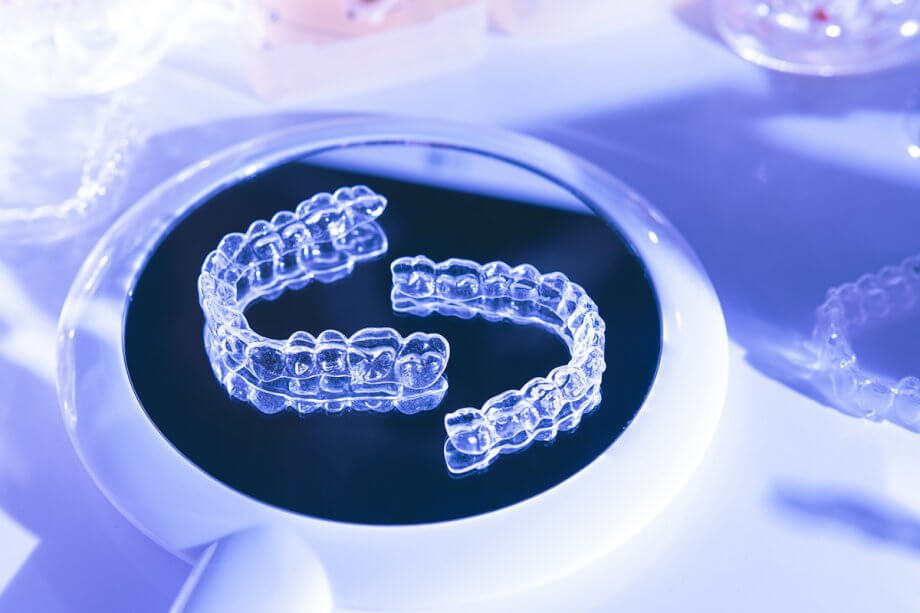Invisalign is convenient, discreet, and highly effective. For most patients, it also works more quickly than traditional metal braces. Invisalign treatment frequently takes between 12 and 18 months to complete.
Advantages of Invisalign
Discreet
Traditional braces attract attention and intrusive comments. Many adults and older teen patients prefer to keep their orthodontic treatment private.
Comfortable
The aligners are smooth medical-grade plastic with no metal wires or brackets. They do not damage or irritate the gums or other sensitive oral tissues. When patients wear their aligners, most report that they are hardly noticeable.
Gentle
Unlike braces, Invisalign requires no uncomfortable adjustment appointments. Invisalign works gradually, shifting teeth one at a time for best results. Patients may feel pressure or discomfort when changing to a new aligner, but this sensation should pass.
Easy Care
Patients must remove their aligners for cleaning, eating, and drinking. Caring for aligners is significantly easier than keeping teeth clean, with traditional braces getting in the way.
Patients keep their aligners clean with a soft toothbrush and clear, unscented liquid antibacterial soap or Invisalign's branded crystals.
No Food Restrictions
Since the aligners come out to eat and drink, Invisalign has no food restrictions. Braces patients must avoid hard, crunchy, sticky, and chewy foods like steak, popcorn, candy, and corn on the cob. As long as patients keep their teeth and aligners sparkling clean, they can eat what they like and replace them later.
Better Oral Health
Caring for metal braces can be challenging, especially reaching trapped food and plaque between the wires, brackets, and tooth surfaces.
Invisalign eliminates these problems and allows excellent oral hygiene with no interference. Braces patients' oral health sometimes suffers due to the difficulty of keeping teeth clean. Invisalign patients can practice more effective oral hygiene.
The Invisalign Process
The Invisalign system creates a graduated series of clear plastic aligners that gently move teeth to their ideal positions. Invisalign remains one of today's most popular methods of aligning patients' smiles and improving oral health.
Step 1: Designing the Aligners
To design the aligners, the dentist first takes digital impressions using the iTero intraoral scanner. Digital impressions are faster and more comfortable than traditional impressions, eliminating mess.
The dentist uses the digital scans to create a 3-D model of your teeth. Using this model, they design the aligners. Your dentist can reveal what your smile will look like upon the treatment's completion.
The dentist then sends the scans and designs to the Invisalign lab, creating the final product.
Step 2: Wearing the Aligners
When the dentist receives the aligners, the patient visits for an initial appointment. The dentist checks the aligners' comfort and fit. They educate the patient on how to wear their aligners for best results.
During treatment, patients wear each aligner for approximately one to two weeks, taking them out to eat, drink, and keep the teeth and aligners clean. Patients must wear the aligners for at least 22 hours daily to ensure effective treatment.
Step 3: Completion
The Invisalign process takes about 12 to 18 months. After wearing the final aligner, the patient must use a retainer as prescribed to ensure the teeth stay in position.
Who is a Good Candidate for Invisalign?
- Busy adults and older teens who do not want to draw unwanted attention to their teeth
- Patients with excellent oral hygiene
- Patients who have the discipline to wear aligners 22 hours daily and keep them clean
- No untreated tooth decay or gum disease
- Patients with no missing teeth
Frequently Asked Questions About Invisalign
Can Invisalign correct an overbite?
The aligners can correct mild to moderate dental bite issues. Sometimes, practitioners use "buttons" made of composite resin and elastics to help align the jaws. Most dentists recommend traditional braces for severe overbites, underbites, crossbites, and open bites.
What happens if you don't wear your aligner as prescribed?
If you can't follow treatment instructions, you will experience delayed results. Your treatment may not work, and you may lose your investment. Dentists remind patients that Invisalign requires responsibility and dedication. In the end, the results are worth it.
Call 508Dentist
If you want to know more about Invisalign, we can help. Please contact us at our Swansea, MA, or North Attleborough, MA, locations to schedule an Invisalign consultation with one of our expert dentists today.

